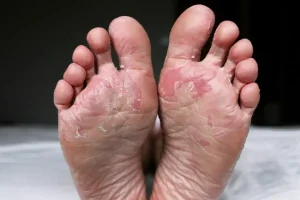Foot blisters can be a painful and frustrating condition, often caused by friction, heat, or moisture. Understanding how to properly address and prevent blisters is essential for maintaining foot health. This guide will explore effective strategies for treatment and prevention, especially for residents of Illinois, including Chicago, Elmhurst, Tinley Park, Downtown Chicago, and Flossmoor.
What Are Foot Blisters?
Foot blisters are small pockets of fluid that form on the outer layer of skin. They can appear anywhere on the foot, but they are most commonly found on the heels, toes, and soles. Blisters can be filled with clear fluid, blood, or pus, depending on the cause.
Causes of Foot Blisters
- Friction:
The most common cause of blisters is friction from shoes or socks that rub against the skin. - Moisture:
Excess moisture from sweat or wet conditions can increase the risk of blisters. - Heat:
High temperatures can lead to skin irritation and blister formation. - Allergic Reactions:
Reactions to materials in shoes or socks can also result in blister development.
How to Treat Foot Blisters
- Leave the Blister Intact
What to Do:
If the blister is small and not painful, it’s best to leave it intact. The skin over the blister acts as a protective barrier against infection. - Clean the Area
What to Do:
If the blister breaks, gently wash the area with soap and water to prevent infection. - Apply a Bandage
What to Do:
Use a sterile bandage or blister pad to cover the blister. This protects it from further friction and allows it to heal. - Use Antiseptic Ointment
What to Do:
Apply a thin layer of antiseptic ointment to prevent infection, especially if the blister has burst. - Pain Relief
What to Do:
Over-the-counter pain relievers such as ibuprofen or acetaminophen can help manage discomfort.
When to Seek Medical Attention
If a blister becomes increasingly painful, shows signs of infection (such as redness, swelling, or pus), or if you develop multiple blisters that don’t improve with home treatment, consult a healthcare provider or podiatrist.
How to Prevent Foot Blisters
- Choose the Right Footwear
What to Do:
Select shoes that fit well and provide adequate support. Avoid shoes that are too tight or loose. - Wear Moisture-Wicking Socks
What to Do:
Opt for socks made from moisture-wicking materials that help keep your feet dry and reduce friction. - Use Blister Prevention Products
What to Do:
Consider using blister prevention pads, lubricants, or antifriction products on areas prone to blisters. - Break in New Shoes Gradually
What to Do:
When wearing new shoes, gradually increase the time you spend in them to allow your feet to adjust. - Keep Feet Dry
What to Do:
Change damp socks and shoes promptly. Consider using foot powder to keep your feet dry. - Monitor Foot Health
What to Do:
Regularly check your feet for any signs of blisters or irritation, especially if you engage in activities that put stress on your feet. - Stay Hydrated
What to Do:
Proper hydration can help regulate body temperature and reduce sweating, minimizing the risk of blisters.
Conclusion
Foot blisters can be a common nuisance, but with proper treatment and preventive measures, you can maintain healthy and comfortable feet. If you’re experiencing persistent issues or live in Illinois, including Chicago, Elmhurst, Tinley Park, Downtown Chicago, or Flossmoor, consult a healthcare provider or podiatrist for personalized advice. Don’t let foot blisters hold you back—take steps to protect your feet today!




